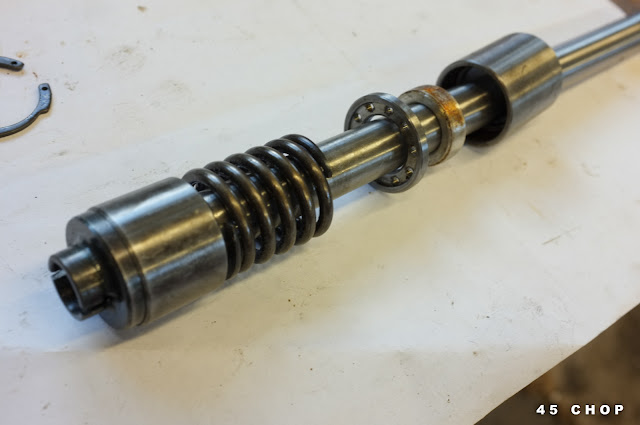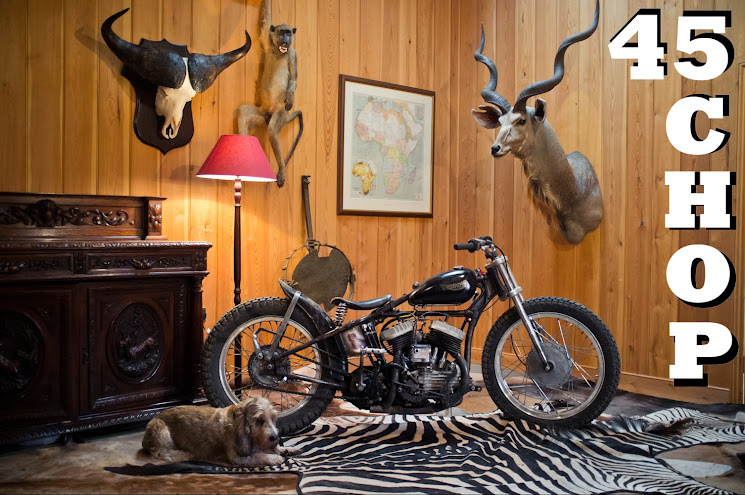A lack in continuity
I did this a while ago but forgot to blog it (God knows how, bloggin is my noggin)..

Spring mechanics:
Changing the preload spacer does not change the stiffness.
Changing the preload only affects the ride height.
Reducing the preload will lower your bike but it will likely bottom out a lot.
Putting a spacer on the bottom of the damper will reduce the travel.
It will stop your forks extending fully and the bike will sit lower.
Reduced travel has it's downsides and you will need different springs or small bumps will not be absorbed.
Shorter forks and shorter springs will retain full travel and just sit lower.
Unless your springs are really short and constrict travel.
Shorter springs are stiffer. This means they move less for the same load.
Spring length, geometry (ie coil density) and material are the only factors which affect stiffness.
Dampers and oil affect damping - how quickly forks react.
Bought some 2" under fork tubes from Frank
And a repro later-style damper from V-twin manufatcats. Better than the long cartridge(?) style original K-model ones, apparently. Also better for lowering your forks as you don't need to cut down the damper.
I can't identify the different sportster fork sliders but these ones have a waisted bottom (photo above), no seal at the top (photo below) and the K fender wings (obviously). Anyone know?
The bushings were a bit tight for the new tubes so I opened them up a bit with this clever little contraption.
Those later dampers need a larger hole in the bottom than the K's, fortunately these were already big - maybe altered years ago or later-than-I-thought sportster forks?
So this is the stock length spring in the assembled lower forks. Last stage is just to cut 2" off.
THIS DIDN'T WORK
THIS DIDN"T WORK WELL
(in the end I used a thin cut off wheel on an angle grinder - much neater)
BEFORE

AFTER
I lowered my K model forks by two inches. There are several ways to lower forks but this way is easily the best.
Spring mechanics:
Changing the preload spacer does not change the stiffness.
Changing the preload only affects the ride height.
Reducing the preload will lower your bike but it will likely bottom out a lot.
Putting a spacer on the bottom of the damper will reduce the travel.
It will stop your forks extending fully and the bike will sit lower.
Reduced travel has it's downsides and you will need different springs or small bumps will not be absorbed.
Shorter forks and shorter springs will retain full travel and just sit lower.
Unless your springs are really short and constrict travel.
Shorter springs are stiffer. This means they move less for the same load.
Spring length, geometry (ie coil density) and material are the only factors which affect stiffness.
Dampers and oil affect damping - how quickly forks react.
When lowering my forks I pretty much forgot all the maths and freestyled it. I wanted low stiffness to maximise the travel off-road so I left my springs as long as possible with normal preload (a third of the total travel when sitting on the bike) which basically meant no preload spacer.
It worked well, the forks bottom out with the sliders a mere 1mm from the lower tree and they've only bottomed out once when riding when I did a fairly large jump. The stance looks a bit tighter as well which was the main point I guess.
Inside and out
Before
After
One coat of white
Three coats of white
Lacquered
How to turn a rusty, lumpy tank white, inside and out:
Empty petrol
Weld cracks
Extinguish fire
Strip off rust and paint
Buy spare wire brush
Degrease with potent panel wipe
Mix primer, paint a coat and dry
Go back to work for a week
Order sealant kit
Wash inside with detergent
Mix rust converter
Add for 3 hours, sloshing regularly
Wash suspected sulphuric acid rust remover out of eye, thoroughly
Empty over fence in neighbour's garden
Horse around with 100g of white powdered De-Ox
Mix with warm water and add for 1 hour
Wash out with spirits
Dry thoroughly, admire hoover trick
Heat tank sealant and tank to 50oC
Congratulate yourself on finding use for infra red thermometer gun
Mix hardener and poor in tank, coating thoroughly
Worry about missed spot
Second coat of primer
Three coats of white with alternating brush directions
Two coats of laquer
Photograph and blog
Subscribe to:
Comments (Atom)










































